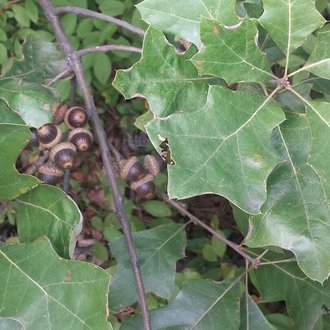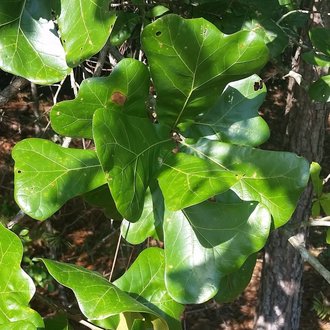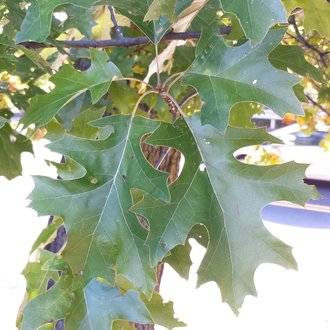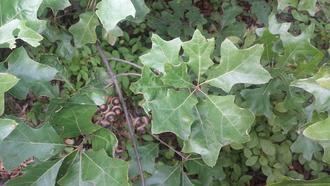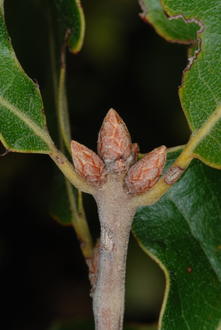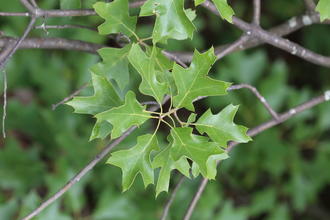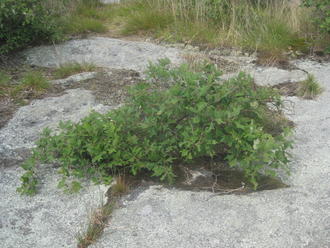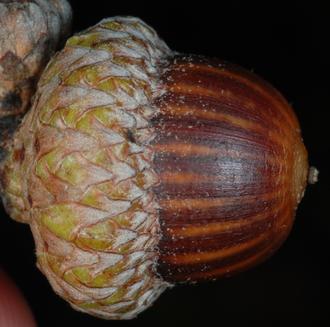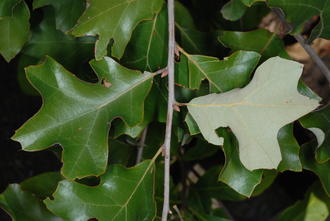Bear Oak (Quercus ilicifolia Wangenh.)
Also known as scrub oak.
↑Summary
A small, shrubby oak, typically inhabiting harsh habitats, such as fire-prone barrens or rock outcroppings, where large trees cannot grow.
↑Range - Expand
| Legend | Color |
| Native | |
| Native or Not Present |
This tentative map is based on our own research. It may have limited data on Canada and/or Mexico, and there is some subjectivity in our assignment of plants as introduced vs. expanded. Read more in this blog post.
Although this plant occurs somewhere in each of these regions, it may only occur in a small part of some or all of them.
↑Description & Identification
Bear oak is often confused with other oaks that can be found in harsh, barren habitats. It can occur together with other oak species, and these other species can have altered appearances that make them look more similar to this species than they would in other habitats.
↑Similar Plants
↑Habitat
Found on dry, barren sites with good drainage, in the Appalachians, northeastern US, and slightly into Ontario. Natural habitats include mountaintops, rock outcroppings, talus slopes, sandy uplands, and barrens, including sandy and rocky pine barrens as well as serpentine barrens. Many of these habitats tend to be sloped, but this species can be found on flat sites as well so long as they are well-drained. Also found in anthropogenic habitats including power line rights-of-way and along roadsides, especially in areas with coarse sandy soils.
Fond on soils ranging from rocky to sandy, but always well-drained, often excessively so. Soils tend to be acidic and low in fertility and organic matter. Preferred soils tend to be low in calcium and magnesium, but may be high in aluminum and iron. In mountains, it is often found on shallow soils, but it is also found on deep sands.
Intolerant of salt spray and absent from coastal locations.
Found in fire-prone habitats that experience severe, crown-destroying fires; adapted to some of the most extreme fire regimes of any woody plants in its range. Fire return intervals vary from 5 to 60 years, and intervals of 6-8 years are typical. Also tolerates and may benefit from human-induced disturbances including clearcutting and herbicide use, which in some respects mimic fire.
On richer sites capable of supporting taller vegetation such as pitch pine (Pinus rigida) and taller oaks, bear oak is only found temporarily, in early successional stages following disturbance. It persists longer on harsher sites and sites with regular, severe disturbance.
↑Life Cycle
Unlike most oaks, bear oak is a thicket-forming shrub that often sends up multiple stems from a single root system.
Seeds germinate in the spring, triggered by warm temperatures following a period of cold dormancy in winter, as is typical with oaks of the red oak group. Also atypical among oaks, seedlings tend to grow rapidly in the first year, followed by slowing aboveground growth in subsequent years. Seedlings may grow up to 16 inches in their first year, and average 12-14 inches, but typically only grow a few inches in subsequent years. This growth pattern allows this species to rapidly establish and develop high photosynthetic capacity in the first year, and then invest subsequent growth into the root system so that it can survive subsequent top-kill, a pattern that reflects the open conditions in which it tends to germinate.
The structure of the root system varies considerably based on the site's soil structure. Some plants grow a single, large and irregular taproot; others grow multiple taproots and/or multiple large lateral roots, or oblique roots (diagonal roots extending both down and laterally.) Roots may extend to a depth of about 3 feet, but are shorter on many sites. Roots are intolerant of saturated conditions, avoiding the water table even if it is within typical reach of the root system.
This species resprouts vigorously if top-killed. On experiment found that, if cut twice a year, it survived 11 such cuttings. Unlike most oaks, bear oak not only resprouts if top-killed, but also reproduces vegetatively even in the absence of top-kill. Vegetative reproduction is also more important than reproduction by seed in some populations.
Different authors and studies have reported different patterns of seed production. Multiple studies have reported seed production peaking between 4 and 9 years, and continuing as long as 24 years, for a particular stem, but another study found seed production increased to at least 30 years. The particular pattern of seed production may vary by site and may be dependent on site conditions. Seed production tends to diminish and stop entirely as this plant gets shaded by taller vegetation, which often happens from pitch pine (Pinus rigida), and may also happen from other, taller, drought-tolerant oaks such as blackjack oak (Quercus marilandica) or post oak (Quercus stellata), or on richer sites, white oak (Quercus alba) or black oak (Quercus velutina).
However, plants can stay alive for many years when shaded, persisting in the understory, and may reestablish dominance following a series of severe disturbances that kill other less disturbance-loving trees.
Individual stems typically live 20-30 years, but may live shorter on frequently-disturbed sites. The root system may live much longer than this.
↑Faunal Associations
Bear oak is critically important in providing cover in the barren habitats where it occurs. Bear oak thickets have high value to wildlife as cover, and they tend to occur in areas that would have much less cover in the absence of this species.
The acorns are eaten by a variety of mammals as well as birds. Numerous squirrel species, as well as chipmunks, eat the acorns, and all of these are important in distributing the seeds through caching them.
White-tailed deer browse this species, primarily consuming the stems and acorns in late winter when other food is scarce. Less commonly, deer will browse the tender growth of resprouts following a fire. The importance of this species is greatest following severe fires, when other food becomes scarce. Under other conditions, this species is mostly ignored by deer in part because the leaves are tough and not particularly nutritious.
Bear oak creates important habitat for birds that prefer foraging in low-growing shrubs, including the gray catbird, golden-winged warbler, chestnut-sided warbler, and field sparrow. This species is particularly important to birds in spring, where it supports at least 17 species of birds that forage in it.
↑Links & External Resources
• Bear Oak | Fire Effects Information System (FEIS) (About This Site)
• Quercus ilicifolia (Bear Oak) | USDA PLANTS Database (About This Site)
• Quercus ilicifolia | Go Botany (About This Site)
• Bear Oak | Virginia Tech Dendrology Factsheets (About This Site)
• Quercus ilicifolia | Biota of North America Project (BONAP) (About This Site)
• Quercus ilicifolia | NatureServe Explorer (About This Site)
• Quercus ilicifolia | Flora of North America (About This Site)
• Bear Oak | Maryland Biodiversity Project (About This Site)
• Quercus ilicifolia Wangenheim (Bear Oak, Scrub Oak) | Digital Atlas of the Virginia Flora (About This Site)



